Have you always wanted to learn How To Play The Guitar? Maybe you dream of serenading friends, jamming with a band, or simply enjoying the music you create. Millions worldwide share this dream, and you’re taking the first step just by being here!
Learning guitar is a rewarding journey, and it’s never too late to begin. Whether you’re a complete novice or have dabbled before, this guide will provide the essential steps to get you started. We’ll cover everything from choosing your first guitar to strumming basic chords and beyond. Let’s embark on this exciting musical adventure together!
1. Acoustic vs. Electric Guitar: Which is Right for You?
The first big decision is choosing between an acoustic and an electric guitar. Both are fantastic instruments, but they offer different experiences, especially for beginners. Understanding the key differences will help you pick the guitar that best suits your goals and preferences. For a deeper dive, explore our comprehensive guides on acoustic guitars and electric guitars.
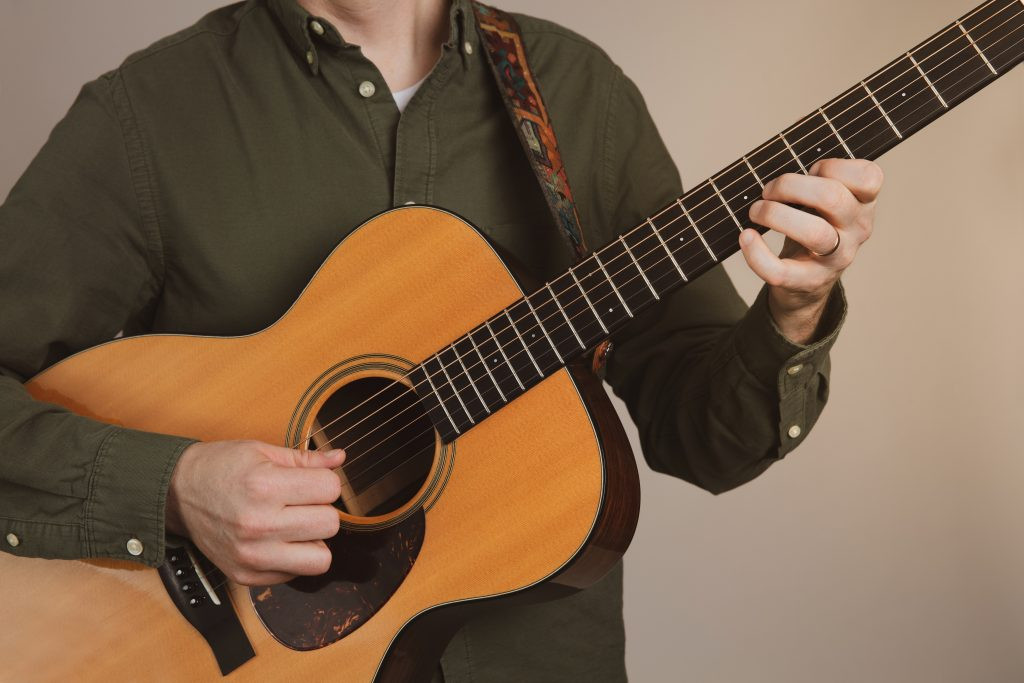 Beginner guitarists choosing between acoustic and electric guitars
Beginner guitarists choosing between acoustic and electric guitars
Acoustic Guitars: Simplicity and Portability
Acoustic guitars are often recommended for beginners, and for good reason. They are generally simpler to get started with as you don’t need any additional equipment like amplifiers. A nylon-string acoustic guitar is particularly gentle on new fingers. Acoustics are also quite portable, perfect for practicing anywhere. While budget-friendly options exist, investing in a decent quality acoustic guitar will provide better sound and playability as you progress.
 Acoustic guitar with nylon strings ideal for beginners
Acoustic guitar with nylon strings ideal for beginners
Electric Guitars: Versatility and Rock ‘n’ Roll
Electric guitars offer a wider range of sounds and are incredibly versatile, especially if you’re drawn to genres like rock, blues, or metal. While typically more expensive upfront because you’ll need an amplifier and potentially cables, an electric guitar can be a motivating choice for beginners eager to explore different tones with effects pedals like distortion. Don’t let the extra gear intimidate you; the sonic possibilities can be inspiring!
2. Get to Know Your Instrument: Guitar Anatomy
Before you start playing, familiarize yourself with the basic parts of the guitar. Understanding guitar anatomy will make learning resources and instructions much clearer. Key guitar parts you should know include:
- Body: The main part of the guitar that resonates sound.
- Fretboard: The wooden surface on the neck where you press down strings.
- Frets: Metal strips across the fretboard that divide the neck into notes.
- Neck: The long piece of wood connecting the headstock to the body.
- Headstock: The top of the guitar neck where tuning pegs are located.
- Strings: Usually six strings that vibrate to produce sound.
- Tuning Pegs (Tuners): Used to adjust string tension and tune the guitar.
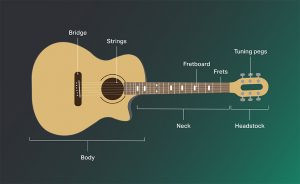 Diagram of guitar parts for beginners
Diagram of guitar parts for beginners
Depending on whether you chose an acoustic or electric guitar, you’ll notice some differences. Acoustic guitars usually have a soundhole in the body to project sound, while electric guitars often have pickups, knobs, and input jacks for amplification and effects.
3. How to Hold a Guitar Correctly
Proper posture and how you hold your guitar are crucial for comfortable playing and preventing bad habits. Whether you’re playing acoustic or electric, seated or standing, there are some fundamental techniques.
Acoustic guitarists often play sitting down, resting the guitar on their lap. You can position the guitar on either your left or right leg, whichever feels more natural.
Electric guitarists can also play seated, but many prefer to stand, especially when performing. For standing, you’ll need a guitar strap to support the instrument.
 Proper guitar posture for beginners
Proper guitar posture for beginners
Orient your guitar so the thickest string (low E string) is nearest to your head when you look down. The hand that presses down on the strings on the neck is called the “fretting hand,” and the other hand, which strums or picks, is the “picking hand” or “strumming hand.” For right-handed players, the left hand is the fretting hand, and the right hand is the picking hand. Left-handed guitarists typically reverse this.
Left-handed players have options: they can learn on a standard right-handed guitar, flip a right-handed guitar to play “upside down,” or use a specifically designed left-handed guitar.
4. Understanding Guitar Strings and the Fretboard
The fretboard and strings are where the magic happens! Guitar strings are named from thickest to thinnest: E, A, D, G, B, and E (often remembered with mnemonics like “Every Adult Dog Growls Bites Eats”). The thickest string, closest to your head when looking down, is the low E string.
Pressing strings down onto the fretboard, known as “fretting,” might feel uncomfortable at first. Your fingertips will toughen up over time, and discomfort will lessen. Nylon strings on classical acoustic guitars are gentler for beginners than steel strings found on most other acoustics and electrics. Ensure you press firmly enough just behind the fret (the metal strip) for a clear sound, not directly on top of it or too lightly.
5. Tuning Your Guitar: Getting in Pitch
Playing a guitar that’s out of tune is frustrating and hinders your learning. Correct tuning is essential! For beginners, stick to standard tuning: EADGBE, from thickest to thinnest string. Forget about alternate tunings for now; mastering standard tuning is the priority.
 Electronic guitar tuner for accurate tuning
Electronic guitar tuner for accurate tuning
Electronic tuners make tuning incredibly easy for both acoustic and electric guitars. However, the most accessible and often free option is a guitar tuner app like GuitarTuna. These apps use your phone’s microphone to detect string pitch, making tuning convenient anytime, anywhere.
6. Basic Guitar Chords: Your First Building Blocks
Before attempting complex solos, master basic guitar chords. Guitar chord charts are visual diagrams showing you where to place your fingers to form chords. Start with “open chords,” also known as “cowboy chords,” which are played in the first few frets and utilize open strings. These include major and minor chords.
If you ever forget a chord, our extensive guitar chord library is always available.
Major Chords: Bright and Happy Sounds
Take it slow and start with a few essential chords. Just a handful of simple chords unlock countless songs! Good major chords to learn first are A, D, C, and G, and E. Here’s an example of a chord chart for the E major chord: ( Chord chart image would be inserted here if available ).
Minor Chords: Melancholy and Emotional Sounds
Great minor chords for beginners are A minor (Am) and E minor (Em). Minor chords are indicated with a lowercase “m.” Listen to the difference: minor chords sound darker and more somber compared to the brighter, happier sound of major chords. Here’s how to play the E minor chord:
 E Minor guitar chord diagram
E Minor guitar chord diagram
7. Strumming Guitar Chords: Creating Rhythm
To play a chord musically, you need to strum across multiple strings simultaneously. For some chords like D and C, you only strum certain strings. This means some chords are initially easier to strum cleanly than others. Avoid accidentally muting strings with your strumming hand.
Once comfortable with basic open chord strumming, experiment with upstrokes, downstrokes, and various strumming patterns and chord progressions. Challenge yourself with different chord types, including barre chords, which require pressing down multiple strings with one finger.
8. Reading Guitar Tablature (Tabs): A Simple Notation
When you want to play melodies, riffs, and more than just chords, guitar tablature, or “tabs,” is your friend. Tabs are a user-friendly way to read music for guitar. They represent guitar strings as horizontal lines and use numbers to indicate which fret to play on each string. “0” means an open string, and “X” represents a muted string. The bottom line is the low E string, and the top is the high E string.
Tabs can show chords, but they also display techniques like slides, bends, hammer-ons, pull-offs, and more – skills you’ll learn as you progress. Learning to read tabs opens up a world of songs and guitar parts.
9. Picking and Using a Guitar Pick (Plectrum)
You can play individual notes with your fingers, called fingerpicking. However, a guitar pick is invaluable, especially for electric guitar and for strumming on acoustic. Picks come in various thicknesses and materials, influencing tone and playing style.
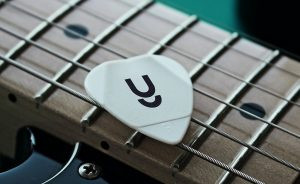 Variety of guitar picks for different playing styles
Variety of guitar picks for different playing styles
Hold the pick between your thumb and index finger, letting the other fingers relax. Don’t grip too tightly. The pick should protrude slightly from your thumb, with your thumb’s nail facing upwards. Practice picking individual strings slowly, then increase speed and alternate between downstrokes and upstrokes. Don’t worry about mistakes initially; accuracy comes with practice.
10. Learning Minor and Major Scales: Exploring the Fretboard
Guitar scales and music theory might seem daunting, but scales are essential for understanding the fretboard and finding notes. They are also fundamental for improvisation and songwriting. Like chords, scales come in major and minor forms.
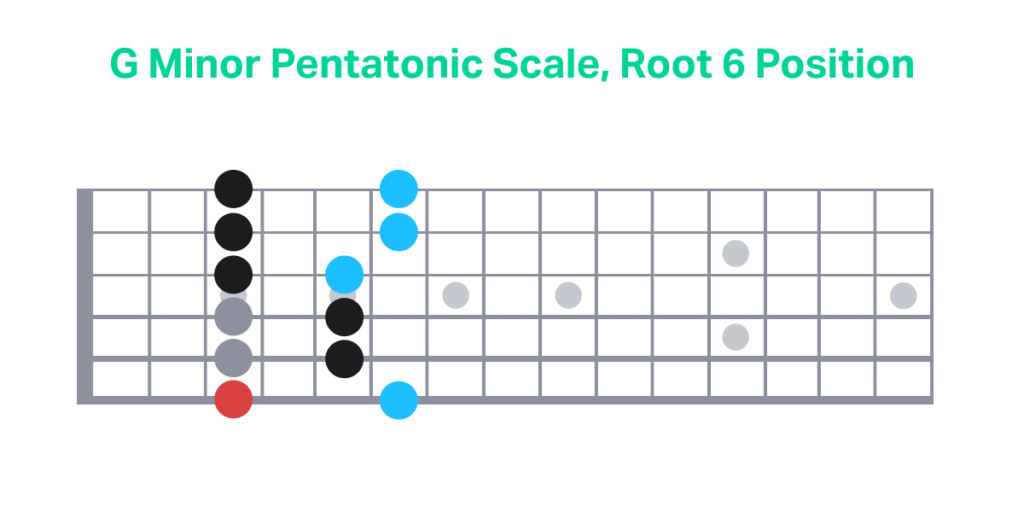 G Minor Pentatonic Scale diagram on guitar fretboard
G Minor Pentatonic Scale diagram on guitar fretboard
Yousician offers interactive exercises to help you master guitar scales. Practice scales up and down to memorize them. As you gain finger dexterity, gradually increase speed.
11. Playing Your Favorite Songs: The Fun Begins!
Now for the most exciting part: playing songs you love! Forget bulky songbooks; the internet is a vast resource for guitar tabs and chords for almost any song. Simply search online for “[song title] tab” or “[song title] chords.”
Interactive learning apps like Yousician offer another fantastic way to learn songs. Yousician’s extensive song library includes diverse artists and genres. Your favorite song might be waiting for you to learn it right now!
12. Practice, Practice, Practice: Consistency is Key
Once you grasp chords, tuning, fretboard navigation, and tabs, consistent practice is paramount. Make guitar a part of your daily routine. Finger soreness is normal initially, but your hands will adapt, building strength and muscle memory.
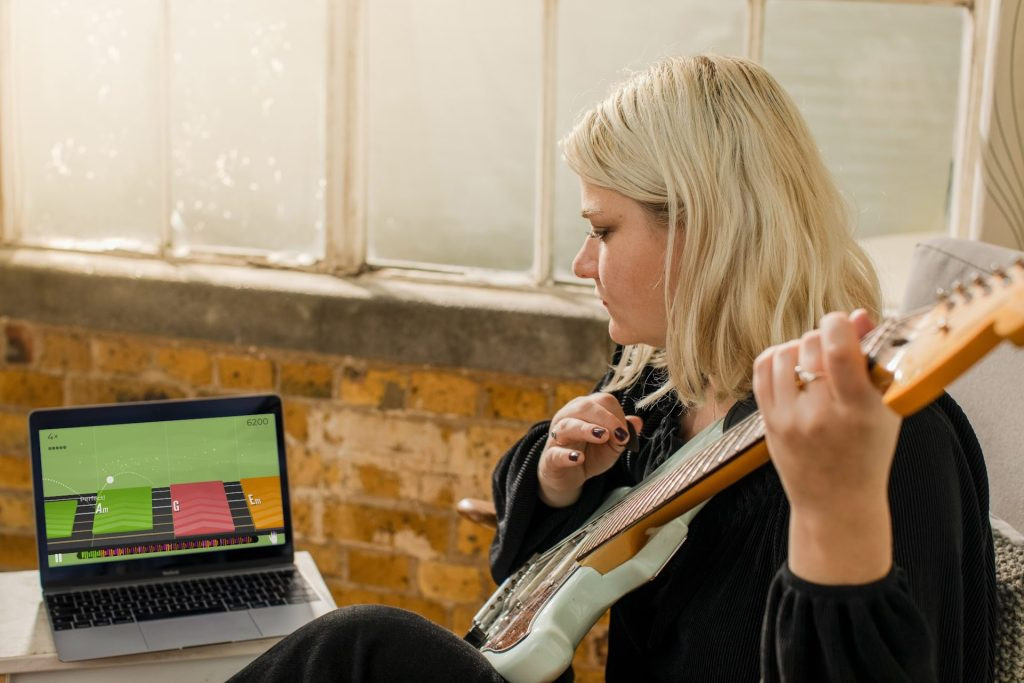 Woman practicing guitar with Yousician app on laptop
Woman practicing guitar with Yousician app on laptop
Learn Guitar Basics with Yousician!
While practice is vital, remember that learning guitar should be enjoyable! Motivation dwindles if it feels like a chore. That’s where Yousician can help.
Yousician acts as your personal guitar teacher, guiding you through interactive lessons at your own pace. Our song library makes practice fun and engaging, with real-time feedback to motivate your progress.
Download Yousician on your computer or mobile device and start your musical journey today.
Frequently Asked Questions About Playing Guitar
Starting guitar comes with many questions. Here are some encouraging answers for aspiring guitarists:
How Long Does It Take to Learn Guitar?
Learning time varies greatly. Practice frequency, practice quality, and individual aptitude all play a role. Prior musical experience can be helpful.
Consistent practice is key to progress. You can move beyond beginner level in months and reach intermediate level within one to three years. Guitar mastery is a lifelong pursuit – always something new to learn!
How Often Should I Practice Guitar?
Aim for 15-30 minutes most days as a beginner. If you’re enjoying it, play longer! Don’t be discouraged by occasional missed days. Consistency is more important than marathon sessions. Focus during practice sessions and, most importantly, have fun!
Do I Need Music Theory to Play Guitar?
You can play guitar without deep music theory knowledge. However, basic theory enhances understanding and accelerates learning. Don’t let theory be a barrier if you just want to play songs you love!
How Can I Learn Guitar at Home?
Starting from scratch can feel overwhelming. Guidance is helpful. Online guitar lessons and interactive apps like Yousician make learning at home accessible, even without a traditional teacher.
Can I Teach Myself Guitar?
Absolutely! Many iconic guitarists were self-taught. The internet and music learning technology make self-teaching more effective than ever. With readily available resources, you can learn at home and become a skilled guitarist!
Ready to start playing?
Play the songs you love with Yousician. Try Premium+ free for 7 days. Sign up and start learning now.
Start your free trial

